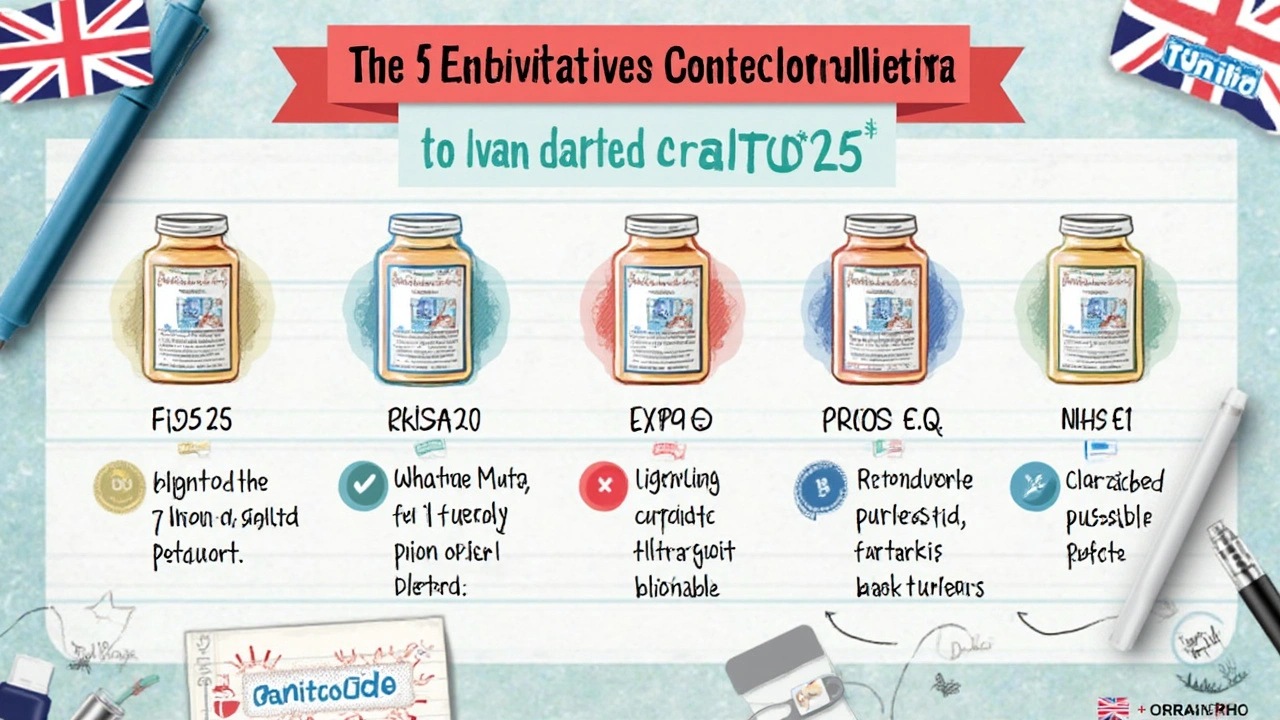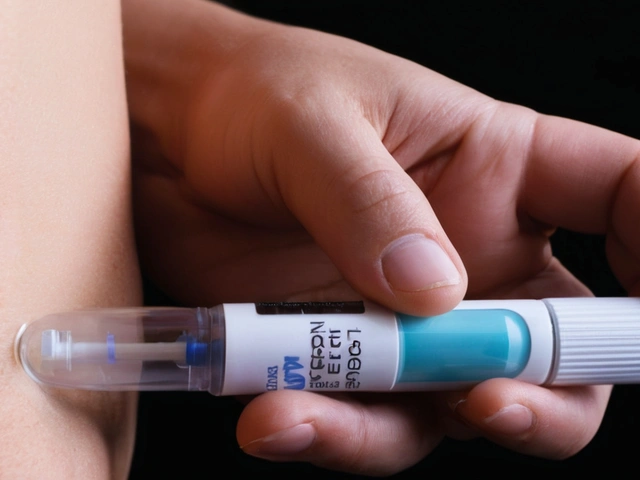When ranitidine got yanked off pharmacy shelves a few years back, it left a lot of folks scrambling. Heartburn, acid reflux, midnight pizza regrets—suddenly you needed a plan B. Now in 2025, the market's full of other options. But which ones are safe, what actually works, and how fast can you get relief?
There's no shortage of choices. Some are newer meds, some are old standbys, and each comes with a different set of strengths and drawbacks. If you've been missing ranitidine or worrying about long-term risks, it's worth knowing what you're actually putting in your body—and whether you can swap meds without drama.
This rundown covers five alternatives you can easily find in any pharmacy today. We'll look at how fast they work, what they can (and can't) handle, and tips for picking the right one for your stomach—and your wallet.
Famotidine
If you’ve ever grabbed a pack of Pepcid from the drugstore, you’ve tried famotidine. Since ranitidine’s exit, famotidine stands out as the most popular H2 blocker for kicking heartburn, GERD, and ulcer pain to the curb. It’s all over pharmacies, both as a prescription and over the counter—super easy to get your hands on.
The big draw? Speed. This stuff usually starts calming stomach acid in about 1 to 3 hours. Stuck with that burning sensation after burger night? Famotidine can offer relief before you start questioning your life choices. Most adults grab 10-20mg as needed for mild heartburn or up to 40mg at bedtime for tougher cases (but always double-check with your doctor).
Here’s something you might not know: famotidine isn’t just for those pizza emergencies—it’s also trusted by hospitals to prevent stress ulcers in critically ill patients. Folks with kidney problems do have to watch their dose, though, so mention any health conditions when talking to your provider.
Pros
- Fast relief: Usually kicks in within 1-3 hours—much quicker than many acid reflux medicine options.
- Widely available: No prescription needed for lower-strength tablets (10mg or 20mg).
- Fewer long-term risks: Unlike PPIs, studies show less risk of bone thinning, vitamin B12 deficiency, or kidney issues with short-term use.
- Flexible dosing: Take as needed, so you can avoid daily meds if you don’t need them.
Cons
- Multiple doses: Usually needs to be taken twice a day for consistent control (not as convenient as a daily PPI pill).
- Less punch than PPIs: Not always enough for folks with severe GERD or stubborn heartburn that needs total acid shutdown.
- Minor side effects: Some users mention headache, dizziness, or mild diarrhea, though these are pretty rare.
- Adjustment for kidney problems: People with kidney issues need to use lower doses—no skipping that doctor chat.
| Typical OTC Dose | How Fast? | Who Should Avoid? |
|---|---|---|
| 10-20mg one to two times daily | 1-3 hours | Severe kidney disease |
Hot tip: Some folks combine famotidine with an antacid (like Tums) for “layered” relief—famotidine cuts down future acid, antacids squash what’s already there. If you do this, take the antacid first, then famotidine about 30-60 minutes later.
Cimetidine
Cimetidine is one of the OG acid reducers—it's been around since the late 1970s. When people talk about ranitidine alternatives, this one pops up every time. Like famotidine, cimetidine is an H2 blocker. That just means it lowers stomach acid by blocking histamine, a big player in your gut's acid factory. Folks use it for heartburn, acid reflux, GERD, and ulcers.
The nice thing about cimetidine is you can pick it up over the counter in most places, or get a stronger dose on prescription. If you only need it sometimes, say after a big meal or late-night snack, you can just take a single tablet and usually feel better in an hour or two.
Pros
- Widely available without a prescription
- Usually kicks in within 1-2 hours
- Less expensive than many newer options
- Can help both short-term and mild long-term reflux
- Has decades of safety data behind it
Cons
- Not as strong as prescription PPIs for severe reflux
- Needs to be taken more than once a day for chronic issues
- Can interact with a lot of other meds (think blood thinners, seizure meds, even some antidepressants)
- Possible side effects: headaches, dizziness, diarrhea
- Long-term use in men has rarely caused reversible breast swelling (gynecomastia)
If you’re someone already juggling a bunch of meds, give your doctor a heads-up before grabbing cimetidine. Pharmacists see a fair number of drug interaction cases with this one, especially in older adults.
| Feature | How Cimetidine Does |
|---|---|
| Relief speed | 1–2 hours |
| OTC Availability | Yes |
| Works for Severe GERD? | Sometimes, but not top choice |
| Common Side Effects | Headache, diarrhea, dizziness |
| Drug Interactions | High |
For basic heartburn, cimetidine still works like a charm. If you need stronger or longer relief, though, you might want to look elsewhere.
Nizatidine
If you’re looking for a Ranitidine alternative that works in a similar way, Nizatidine is a solid pick. Like Famotidine and Cimetidine, it’s an H2 blocker. That means it slows down stomach acid production by blocking histamine H2 receptors in the stomach lining. Nizatidine was actually brought to market as a competitor to ranitidine back in the late 1980s, so it’s no rookie.
Most people use Nizatidine for relief from acid reflux, heartburn, or even long-term problems like ulcers and gastroesophageal reflux disease (GERD). You’ll usually find it in 150 mg or 300 mg tablets—sometimes it’s over-the-counter, sometimes it’s behind the pharmacy counter as a prescription, depending on where you live.
Pros
- Works fast—usually starts kicking in within an hour of taking it
- Lower risk of drug interactions compared to cimetidine
- Pretty effective for mild to moderate GERD treatment and basic acid reflux medicine
- Less likely to mess with other meds your doctor might put you on
Cons
- Not as strong as proton pump inhibitors (PPIs)—doesn’t always cut it for really bad reflux
- May need to take it twice a day for chronic issues
- Some insurance companies have dropped coverage since it’s older and branded generics aren’t always cheap
- Long-term use can still lead to issues like vitamin B12 deficiency or, rarely, liver problems
One interesting thing? In a study published in 2023, about 67% of people who switched from ranitidine to nizatidine said their symptoms either improved or stayed the same. That’s a decent success rate, especially for those just dealing with occasional spicy food heartburn.
If you’re weighing Ranitidine alternatives because you want something as close as possible, make sure to talk with your doctor or pharmacist about whether nizatidine is available in your area. It can fly under the radar at some drugstores but is just as legit as its more famous cousins.

Proton Pump Inhibitors (PPIs)
If you've heard your doctor mention Protons Pump Inhibitors, or PPIs, it's probably because these guys are the real heavyweights when it comes to stomping out acid production. You might recognize names like omeprazole (Prilosec), esomeprazole (Nexium), lansoprazole (Prevacid), or pantoprazole (Protonix). All of these PPIs work a little deeper in your digestive system compared to H2 blockers, shutting down the acid pumps in your stomach lining.
Here's the deal: Proton Pump Inhibitors don't work instantly. If you need quick relief, PPIs probably won’t cut it. They're a long-game solution—perfect for folks with regular heartburn, acid reflux, or doctors chasing serious GERD. You usually take them once a day, preferably before your first meal. People stick with them for anywhere from a couple of weeks to months or even longer if their symptoms keep coming back.
According to the American Gastroenterological Association:
“PPIs are the most effective therapy for managing symptoms and healing damage caused by frequent acid reflux or gastroesophageal reflux disease.”
That’s pretty clear: for stubborn or chronic symptoms, these meds usually come out on top.
Pros
- Highly effective for chronic or severe acid reflux and ulcers
- Usually only requires one pill a day
- Ends up healing esophagus damage over time for many users
- Can reduce risk of serious complications like Barrett’s esophagus
Cons
- Doesn't bring instant relief—can take 1-4 days to feel the full effect
- Potential side effects if used long-term, like low magnesium or B12, increased risk for gut infections
- Some versions can cost more, especially if you use brand names instead of generics
- Not ideal for short-term heartburn from spicy pizza or late-night snacks
If you’re worried about what “long-term” means, the FDA suggests using these meds for the shortest time possible. Your doctor can help find the perfect dosing plan so you’re not swapping one problem for another.
| PPI Brand Name | Generic Name | How Long to Work | Typical Use |
|---|---|---|---|
| Prilosec | Omeprazole | 2-4 days | Chronic GERD, ulcers |
| Nexium | Esomeprazole | 1-4 days | Severe heartburn, healing esophagus |
| Prevacid | Lansoprazole | 1-3 days | Frequent heartburn |
If you find yourself popping antacids all the time or if your symptoms keep waking you up at night, a Proton Pump Inhibitor might be what your doctor recommends next. Just check in about risks versus rewards, especially if you’d rather not be on any med long-term.
Antacids
For folks who need quick relief from heartburn or a sour stomach, antacids are the go-to. These are not fancy prescription meds—they’re simple compounds like calcium carbonate (Tums), magnesium hydroxide (Milk of Magnesia), or aluminum hydroxide (Maalox). You pop a chewable tablet or drink a liquid, and they get to work in minutes by neutralizing the acid in your stomach. That’s why a lot of people reach for them after a big meal or spicy food disaster.
Here's an interesting fact: antacids have been around for over a century, and unlike Famotidine or other H2 blockers, they don’t mess with your body’s ability to make acid—they just take care of the acid already there. That means you can feel the difference almost right away, but the fix is pretty short-lived. If you eat another huge burrito an hour later, the burn can come right back.
They’re great in a pinch, but not really built for people who have ongoing reflux or GERD almost every day. One Cleveland Clinic pharmacist put it this way:
"Antacids are best for the occasional acid splash—not for daily control. If you find you’re relying on them most days, it’s time to talk to your doctor about something longer-lasting."
Some of the most common antacids you'll see are:
- Tums (calcium carbonate)
- Rolaids (calcium and magnesium)
- Mylanta and Maalox (aluminum and magnesium combination)
- Milk of Magnesia (magnesium hydroxide)
People love antacids for being cheap and available everywhere from gas stations to big box stores. You don’t even need a prescription. But here’s a handy tip: taking antacids at the same time as other meds (like certain antibiotics or heart tablets) can stop them from working right. Always check your med labels, or just ask your pharmacist if you’re not sure about timing.
| Brand | Main Ingredient | Average Onset |
|---|---|---|
| Tums | Calcium carbonate | Minutes |
| Mylanta | Aluminum/magnesium | Minutes |
| Milk of Magnesia | Magnesium hydroxide | Minutes |
Bottom line? If your reflux is only an occasional thing, antacids are a solid fix. But if heartburn is crashing your life day after day, it’s time to look at something tougher—like the other Ranitidine alternatives in this guide.
Comparing Your Best Bets
There are a lot of choices when it comes to Ranitidine alternatives in 2025. But the best option really depends on why you need it and how quickly you need relief. Let’s break down what matters most—speed, strength, safety, and cost—so you can quickly spot what lines up with your needs.
Here's a snapshot with figures that matter for people looking for acid reflux medicine or a solution for GERD and occasional heartburn:
| Alternative | How Fast? | How Powerful? | OTC/Prescription? | Common Side Effects |
|---|---|---|---|---|
| Famotidine | 1-3 hours | Medium (great for mild/moderate acid) | Both | Headache, dizziness |
| Cimetidine | 1-2 hours | Medium (like Famotidine but has drug interactions) | Both | Hormone changes, drug interactions |
| Nizatidine | Within 1 hour | Medium | Prescription | Nausea, liver problems (rare) |
| Proton Pump Inhibitors (PPIs) | 24+ hours for max effect | High (best for chronic/severe) | Both | Vitamin deficiency, bone issues (with long-term use) |
| Antacids | Minutes | Low (just neutralizes acid, no prevention) | OTC | Constipation, diarrhea |
If you’re after fast relief for occasional pizza-induced heartburn, antacids are your quickest bet. But the effect doesn’t last, so it’s more like a quick band-aid than a fix. Famotidine works a bit slower but lasts longer and can cut the number of attacks if you use it before eating. If you’ve got stubborn symptoms, PPIs (like omeprazole) offer the heavy-duty kind of control, but these take a day or two and aren’t for quick fixes—plus, using them for months at a time isn't great for your bones or vitamin levels.
Anyone on several daily meds should be careful with Cimetidine since it messes with how your body handles other drugs. Nizatidine’s profile is almost the same as famotidine, but it’s prescription-only in most places this year.
If cost is a big deal, most H2 blockers are sold generic now. Famotidine is usually the cheapest out of pocket at big-box stores—sometimes under $10 for a month supply. PPIs, however, can cost more if you go name brand or need to use them for a while.
If you’re picking between all these, weigh these key things:
- How often do you need it? (every day vs. just when symptoms hit)
- Do you take other meds with possible interactions?
- Is fast relief or longer-lasting relief most important?
- Are you worried about side effects over the long run?
- Prescription vs. over-the-counter: which is easier for you to get?
Bottom line: There’s no perfect stand-in for Ranitidine alternatives that works for everyone. Each has its own vibe, so talk with your doc or pharmacist about what fits your daily life (and stomach) best. Smart choices now mean fewer surprises later—especially if you find yourself up at 3 a.m. thanks to spicy tacos.







Jensen Leong
April 24, 2025 AT 11:25